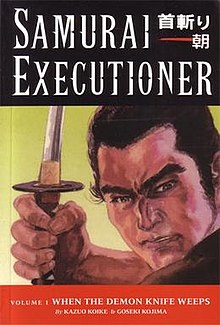Samurai Executioner
| Samurai Executioner | |
 Samurai Executioner Volume 1 | |
| 首斬り朝 (Kubikiri Asa) | |
|---|---|
| Genre | Drama, Historical |
| Manga | |
| Written by | Kazuo Koike |
| Illustrated by | Goseki Kojima |
| Published by | Kodansha |
| English publisher | |
| Demographic | Seinen |
| Original run | 1972 – 1976 |
| Volumes | 10 |
Samurai Executioner, known in Japan as Kubikiri Asa (首斬り朝), is a 10-volume manga created by writer Kazuo Koike and artist Goseki Kojima, the same team that created the popular Lone Wolf and Cub series. The series was first serialized in Japan, from 1972–1976. Samurai Executioner is set earlier than Lone Wolf and Cub, with the main character of the former series appearing in a chapter of the latter.
The story is set in the Edo period of feudal Japan. It revolves around Yamada Asaemon (山田 朝右衞門, Yamada Asaemon), nicknamed Kubikiri-Asa (literally "Neck-chopper Asa", often translated as "Decapitator Asaemon"), a rōnin who is responsible for testing new swords for the shogun. The character is based on a real-life line of sword-testers who served the Tokugawa Shogunate up to the early 19th century.[1] He is also frequently called upon to perform executions.
Many of the stories focus not on Asaemon, but on several of the people he meets in the course of his work. More often than not they are the stories of the criminals he executes, told as their last words before receiving the fatal stroke. As with Lone Wolf and Cub's Ogami Itto, such encounters often give Asa pause for thought.
Overview[]
Although composed largely of unrelated anthology stories, the series follows Yamada Asaemon (also called Yamada Yoshitsugu and nicknamed Kubikiri Asa),[2] a young rōnin who assumes the post of sword-tester. Asaemon's reputation is fearsome among the populace because he killed both his father and his first love. He performed the former at his father's insistence, as the terminally ill man wanted to test his successor's swordsmanship in an act of seppuku; the latter was his first execution: a criminal who had seduced him as a boy years earlier. He is atypical of portrayals of rōnin in that he has a governmental post, owns a substantial house, and does not normally roam the countryside. He refuses to marry and have a family, stating in the story "Hellstick" (Volume 3: The Hell Stick): "Can a man who lives by killing take a wife and father a child?" However, in the story "Gobari Sandosu" (Volume 6: Shinko the Kappa), he does marry Ame, the daughter of Tome, and immediately divorces her, but tells her that she will always be the wife of his spirit and the only woman he will ever call his wife.
Recurring characters[]
Sakane Kasajiro (坂根 傘次郎), nicknamed Catcher Kasajiro (畳捕り傘次郎): Introduced in the story "Spark Umbrella" (Volume 5: Ten Fingers, One Life); one of Edo's best policemen, who often uses a hook and rope to capture those he arrests. A lower-caste samurai, he looks up to Asaemon as a teacher and colleague and is the person closest to Asaemon. He is married to former criminal Shinko aka "Shinko the Kappa".
Sakane Shinko (坂根 新子), nicknamed Shinko the Kappa (河童の新子): Kasajiro's wife, named for the kappa tattooed on her back. Daughter of executed yakuza Yaheiji (弥兵次), she is a reformed criminal who joins her husband Kasajiro on the Edo police force. Asaemon adopted Shinko and acted in the place of the father in law at her and Kasajiro's wedding.
Crossover with Lone Wolf and Cub[]
Not long after the series' debut, creators Kazuo Koike and Goseki Kojima depicted Asaemon's fate in their other series, Lone Wolf and Cub.[3][4] Years after the events of Samurai Executioner, Asaemon is ordered by his superiors to kill Ogami Ittō, but secret interference by Yagyu Retsudo causes his sword to become damaged. During his duel with Ogami, Asaemon's sword breaks, resulting in his death.
The character is also portrayed by actor Gō Wakabayashi in the "Headhunter Asaemon" episode of the Lone Wolf and Cub television series.[citation needed]
Publication[]
An English translation of the Samurai Executioner series by Dana Lewis and Marc Miyake was published in the United States by Dark Horse Comics beginning in 2004. The series was completed with the tenth volume, released on May 26, 2006.
In 2014, Dark Horse re-released the series, collecting the stories into four larger format "Omnibus" volumes.[5]
Each volume is written with historical accuracy, although the characters themselves are fictional. In the back of each book, Dark Horse has provided a glossary to help define the many Japanese terms used to keep the stories authentic.
List of volumes[]
The ten volumes are as follows (in English from Dark Horse Comics):
- When the Demon Knife Weeps
- Two Bodies, Two Minds
- The Hell Stick
- Portrait of Death
- Ten Fingers, One Life
- Shinko the Kappa
- The Bamboo Splitter
- The Death Sign of Spring
- Facing Life and Death
- A Couple of Jitte
References[]
- ^ Mikito Ujiie. Oo Edo shitai ko: Hitokiri Asauemon no jidai. [Corpses in Edo: The time of Hitokiri Asauemon] (Tokyo, Japan: Heibon-sha, 1999)
- ^ "Review: Samurai Executioner V. 7: The Bamboo Splitter". Dark Horse Comics. Retrieved 2021-09-09.
- ^ "Dark Horse Comics presents Samurai Executioner, a manga masterwork from the creators of Lone Wolf and Cub! :: Archived Press Releases". Dark Horse Comics. Retrieved 2021-03-15.
- ^ "Lone Wolf and Cub Volume 5: Black Wind by Kazuo Koike, Goseki Kojima". Penguin Random House Canada. Retrieved 2021-03-15.
- ^ "Samurai Executioner Omnibus Volume 1 TPB :: Profile :: Dark Horse Comics". www.darkhorse.com. Retrieved 2020-09-27.
- Manga series
- 1972 manga
- Dark Horse Comics titles
- Fictional samurai
- Edo period in fiction
- Gekiga
- Historical anime and manga
- Kazuo Koike
- Kodansha manga
- Samurai in anime and manga
- Seinen manga
